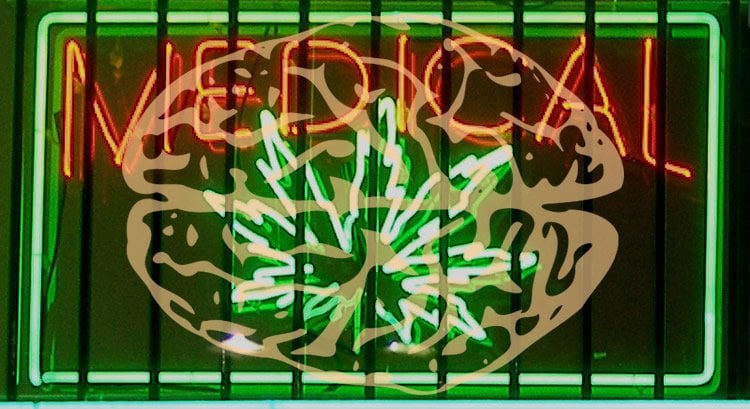Summary: Researchers report THC oil may be beneficial in providing pain relief for those suffering radicular pain, such as sciatica. The study reports marijuana reduces connections between areas of the brain that process sensory signals and emotions.
Source: AAN.
When medical marijuana is taken for chronic nerve pain, it may provide pain relief by reducing connections between the areas of the brain that process emotions and sensory signals, according to a study published in the September 5, 2018, online issue of Neurology. The study looked specifically at radicular pain, a type of nerve pain that radiates from the spine into the legs. Sciatica is a common form of radicular pain.
The component of marijuana examined in this study was tetrahydrocannabinol (THC), one of many cannabinoids found in marijuana and the one most commonly associated with producing a high.
“Pain is a complex experience that involves both the senses and emotions,” said study author Haggai Sharon, MD, of the Sagol Brain Institute, Tel Aviv Medical Center in Israel. “Our study results link pain relief from THC with a reduction in the connections between areas of the brain otherwise heavily connected, suggesting that THC may alleviate pain by disrupting signals between these pain processing pathways.”
The study involved 15 men with chronic radicular nerve pain with an average age of 33. Women were excluded since hormone fluctuations during menstruation may affect pain sensitivity. All participants had medium to high radicular pain for over six months.
Before treatment, participants rated their pain levels and had brain scans with functional magnetic resonance imaging (fMRI) to look at the connections between various areas of the brain. Participants were then given treatment with THC.
For the first visit, nine participants were given an average of 15 milligrams of THC oil placed under the tongue and six were given placebo oil. One hour after treatment, participants were questioned again, and had another brain scan approximately two hours after treatment.
At least one week later, participants returned for a second visit and those who had the placebo now received the treatment, and vice versa.
Researchers found that THC reduces a person’s pain when compared to placebo. On a scale of zero to 100, before taking medication, on average participants rated their pain levels at 53. After taking THC oil, they rated their pain levels at an average of 35 compared to an average of 43 for those who were given the placebo.
In addition, the more pain relief a person experienced, the greater the reduction of connections between the areas of the brain involved in processing pain.

“Interestingly, our results also show that the more connected the areas of the brain that process emotion and sensory prior to treatment, the greater the pain relief experienced when taking THC,” said Sharon. “Larger studies are needed to confirm our findings.”
Limitations of the study are that women were excluded and the number of participants was small. Also, this study looked only at THC. Future studies are needed to examine how other components of the marijuana plant, like cannabidiol, may be useful in relieving pain in combination with THC.
Funding: The study was funded by the Yahel Foundation and the Israeli Ministry of Science, Technology and Space.
Source: AAN
Publisher: Organized by NeuroscienceNews.com.
Image Source: NeuroscienceNews.com image is in the public domain.
Original Research: Abstract for “Cannabis analgesia in chronic neuropathic pain is associated with altered brain connectivity” by Libat Weizman, Lior Dayan, Silviu Brill, Hadas Nahman-Averbuch, Talma Hendler, Giris Jacob, and Haggai Sharon in Neurology. Published September 5 2018.
doi:10.1212/WNL.0000000000006293
[cbtabs][cbtab title=”MLA”]AAN”Marijuana May Bring Relief to Those Suffering Sciatica.” NeuroscienceNews. NeuroscienceNews, 9 September 2018.
<https://neurosciencenews.com/marijuana-sciatica-pain-9931/>.[/cbtab][cbtab title=”APA”]AAN(2018, September 9). Marijuana May Bring Relief to Those Suffering Sciatica. NeuroscienceNews. Retrieved September 9, 2018 from https://neurosciencenews.com/marijuana-sciatica-pain-9931/[/cbtab][cbtab title=”Chicago”]AAN”Marijuana May Bring Relief to Those Suffering Sciatica.” https://neurosciencenews.com/marijuana-sciatica-pain-9931/ (accessed September 9, 2018).[/cbtab][/cbtabs]
Abstract
Cannabis analgesia in chronic neuropathic pain is associated with altered brain connectivity
Objective
To characterize the functional brain changes involved in δ-9-tetrahydrocannabinol (THC) modulation of chronic neuropathic pain.
Methods
Fifteen patients with chronic radicular neuropathic pain participated in a randomized, double-blind, placebo-controlled trial employing a counterbalanced, within-subjects design. Pain assessments and functional resting state brain scans were performed at baseline and after sublingual THC administration. We examined functional connectivity of the anterior cingulate cortex (ACC) and pain-related network dynamics using graph theory measures.
Results
THC significantly reduced patients’ pain compared to placebo. THC-induced analgesia was correlated with a reduction in functional connectivity between the anterior cingulate cortex (ACC) and the sensorimotor cortex. Moreover, the degree of reduction was predictive of the response to THC. Graph theory analyses of local measures demonstrated reduction in network connectivity in areas involved in pain processing, and specifically in the dorsolateral prefrontal cortex (DLPFC), which were correlated with individual pain reduction.
Conclusion
These results suggest that the ACC and DLPFC, 2 major cognitive-emotional modulation areas, and their connections to somatosensory areas, are functionally involved in the analgesic effect of THC in chronic pain. This effect may therefore be mediated through induction of functional disconnection between regulatory high-order affective regions and the sensorimotor cortex. Moreover, baseline functional connectivity between these brain areas may serve as a predictor for the extent of pain relief induced by THC.







